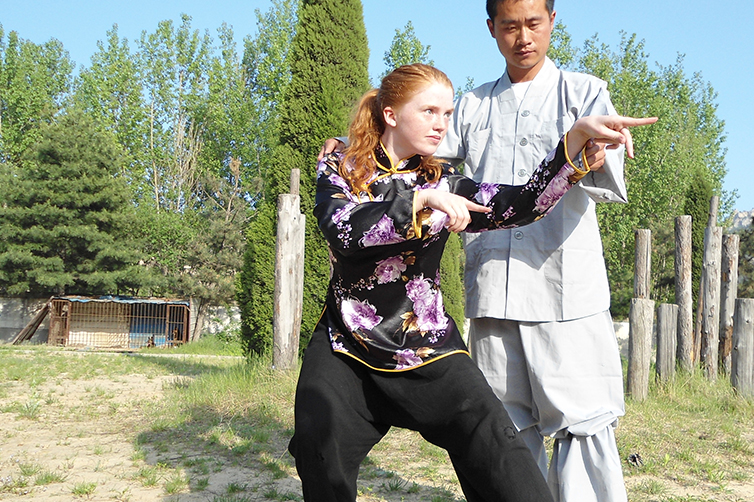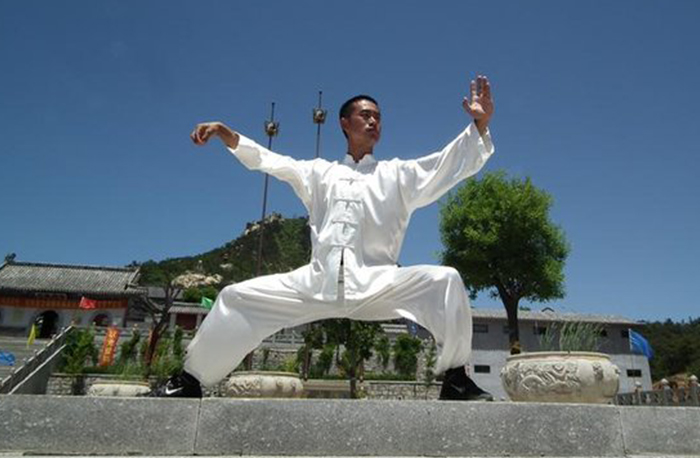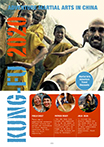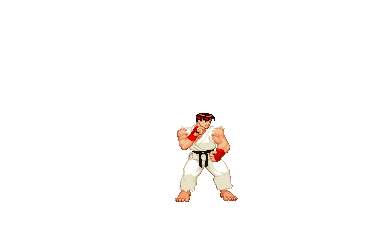Baguàzhang is one of the major "internal" Chinese martial arts. Baguà zhang literally means "eight trigram palm," referring to the trigrams of the I Ching (Yijing), one of the canons of Taoism.
The creation of Baguazhang, as a formalized martial art, is attributed to Dong Haichuan in the early 19th century. He is said to have created it from what he had learned from Taoist, and possibly Buddhist, masters in the mountains of rural China. Evidence suggests Baguazhang is a synthesis of several pre-existing martial arts of rural China combined with Taoist circle walking.
Baguazhang styles include: Yin Style, Shi Style, Cheng Style, Liu Style, Liang Style, Fu Style, Gao Style, Gong Style, Jiang Style and Yin Yang Style. All these styles share the practice of circle walking, or "Turning the Circle". For a beginner traditional training meant walking a circle six to twelve feet in diameter. Practitioners walk around the edge of the circle in various low stances, facing the center, and periodically change direction as they execute forms. Students first learn flexibility and proper body alignment through such exercises, then move on to more complex forms and internal power mechanics. The internal aspects of Baguazhang are similar to, yet distinct from, those of Xingyi and Tai Chi.
Many distinctive styles of weapons are contained within Baguazhang, some use concealment like the "scholar's pen" or a pair of knives (the most elaborate, which are unique to the style, are the crescent-shaped deer horn knives). Baguazhang is also known for practicing with extremely large weapons, such as the B?guàjian or 'Bagua Sword' and B?guàd?o or 'Bagua Broadsword'. Other more conventional weapons are also used like the staff (gun), the spear (qiang), the crutch (guai), the hook sword (gou) and the straight (double-edged) sword. Baguazhang practitioners are also known for being able to use anything as a weapon using the principles of their art.
Baguazhang contains an extremely wide variety of techniques, including various strikes (with palm, fist, elbow, fingers etc), low kicks, joint locking techniques, throws, and distinctively evasive circular footwork. The Baguazhang practitioners are known for their ability to "flow" in and out of the way of objects. This is where the theory of being able to fight multiple attackers came into view.
Strict Baguazhang teaches that if you are to defeat more than one opponent you must first learn to quickly eliminate an opponent with fast and effective joint locks, knockouts, breaks, and other form of physical trauma. Under close examination, Baguazhang can be compared to a form of above ground wrestling. Many of wrestling's philosophies are very similar to Baguazhang's.
Tai chi chuan or Taijiquan is an internal Chinese martial art using hard and soft techniques and represents the fusion of Yin and Yang applied to the human body. Most modern styles of tai chi trace their development to at least one of five traditional schools: Chen Style, Yang Style, Wu/Hao Style, Wu and Sun Style.
Tai chi chuan is generally classified as a soft internal style and its study primarily involves three aspects health, meditation and martial art.
Health: An unhealthy or otherwise uncomfortable person may find it difficult to meditate to a state of calmness or to use tai chi as a martial art. Tai chi's health training therefore concentrates on relieving the physical effects of stress on the body and mind. For those focused on tai chi's martial application, good physical fitness is still an important step towards effective self-defense.
Meditation: The focus and calmness cultivated by the meditative aspect of tai chi is seen as necessary in maintaining optimum health (in the sense of relieving stress and maintaining homeostasis) and in application of the form as a soft style martial art.
Martial art: The ability to use tai chi as a form of self-defense in combat is the test of a student's understanding of the art. Tai chi chuan martially is the study of appropriate changes in response to outside forces; the study of yielding and "sticking" to an incoming attack rather than attempting to meet it with opposing force.
Sanda (Sanshou) or ‘Chinese kickboxing’ has spread and evolved into a Chinese national sport. Sanda is a Chinese hand to hand combat self defense system and combat sport. As a sport Sanda has strict rules to ensure the safety of the two fighters during bouts. The rules prohibit attacks to the back of the head, spine or groin and discontinue combat when a fighter falls to the ground. However, many schools whether traditional or modern, or that practice Sanda for competing or not, practice it as an all round martial arts systems with no restrictions, only adapting their training in relation to competition rules prior to the event. Teaching and practicing techniques to restrain, maim, injure or kill an opponent or opponents. Sanda tournaments are one of the two sport wushu disciplines recognized by the International Wushu Federation.
Sanda or Sanshou is a synthesis of a few traditional Chinese kung fu fighting techniques into a more amorphous system and is commonly taught alongside traditional Chinese styles which Sanshou techniques, theory and training methods are derived from. The emphasis of Sanshou is on realistic fighting ability.
As an unarmed self-defense, close combat system, Sanshou includes da (punches), ti (kicks), shuai (grappling), and na (throws, locks, chokes). Sanda as a sport emphasizes throws in terms of point scoring. One of its most distinguished techniques is the "kick catch". This is when one person kicks and the person performing the throw catches the kick and then trips the person kicking. While kickboxing styles, such as Muay Thai also allow this, the kick catch is emphasized in Sanshou because of the importance it is given by the judges.
Shaolin Boxing is the short form for 'Shaolin Temple Boxing Techniques'. As a means of spiritual discipline, Shaolin Boxing has been integrated in hundreds of schools, with Chan Buddhist influence or Zen guiding its presence. 'Shaolin boxing styles very greatly. There are in fact hundreds of different boxing styles. Students usually will practice general basics and then will devote him or herself to one or two boxing and weapon styles.
Shaolin Kung fu practice is generally talked about in terms of three realms.
1. In the primary realm, the practitioner practices their form and appearance.
2. In the intermediate realm, there is the integration of mind and fist, changing the tangible into the intangible, turning the law into the lawless; obeying no rules, having no movement to follow, controlling the enemy in the intangible. An ancient boxing manual reads, `defeat a person in the intangible or fail being seen`.
3. Shaolin Kungfu's highest realm is for all to be guided by the heart and to fight not just from form but from the formless.
Shaolin Buddhist practice is started in the mindful training of Kung Fu as it cultivates greater awareness. The purpose of learning Kung Fu no longer becomes the goal in itself, but is used as a means of awakening.
Features of Shaolin Kung Fu
1. Short but precise.
2. Box in a line.
3. Casual footwork.
4. Roll in and out.
5. Integration of mind and behavior.
6. Bending but actually not and straight but actually not.
7. Rise high in a tight form and drop in a spreading way. Rise to move with an intention of advance and drop to move with an intention of retreat.
8. Integration of Buddhism and boxing.
9. Focus on defense.
10. Combination of attacking and defending.
11. Numerous tricks.
12. Simple and practical.
13. Vigorous and strong.
14. Numerous acts shrinking back.
15. Numerous kicks.
16. Produce sounds.
Qigong, qi gong, chi kung, or chi gung (simplified Chinese: 气功; traditional Chinese: 氣功; pinyin: qìgōng; Wade–Giles: chi gong; literally: "Life Energy Cultivation") is a holistic system of coordinated body posture and movement, breathing, and meditation used for health, spirituality, and martial arts training. With roots in Chinese medicine, philosophy, and martial arts, qigong is traditionally viewed as a practice to cultivate and balance qi (chi) or what has been translated as "life energy".[1]
According to Daoist, Buddhist, and Confucian philosophy, respectively, qigong allows access to higher realms of awareness, awakens one's "true nature", and helps develop human potential.[2]
Qigong practice typically involves moving meditation, coordinating slow flowing movement, deep rhythmic breathing, and calm meditative state of mind. Qigong is now practiced throughout China and worldwide for recreation, exercise and relaxation, preventive medicine and self-healing, alternative medicine, meditation and self-cultivation, and training for martial arts.
Qigong, qi gong, chi kung, or chi gung (simplified Chinese: 气功; traditional Chinese: 氣功; pinyin: qìgōng; Wade–Giles: chi gong; literally: "Life Energy Cultivation") is a holistic system of coordinated body posture and movement, breathing, and meditation used for health, spirituality, and martial arts training. With roots in Chinese medicine, philosophy, and martial arts, qigong is traditionally viewed as a practice to cultivate and balance qi (chi) or what has been translated as "life energy".[1]
According to Daoist, Buddhist, and Confucian philosophy, respectively, qigong allows access to higher realms of awareness, awakens one's "true nature", and helps develop human potential.[2]
Qigong practice typically involves moving meditation, coordinating slow flowing movement, deep rhythmic breathing, and calm meditative state of mind. Qigong is now practiced throughout China and worldwide for recreation, exercise and relaxation, preventive medicine and self-healing, alternative medicine, meditation and self-cultivation, and training for martial arts.
https://en.wikipedia.org/wiki/Qigong
Seven Star Praying Mantis Boxing the original form of praying mantis kung fu. This style is widespread in China’s Shandong Province and surrounding areas. Luo Guangyu is known for having passed down this style to Hong Kong and other parts of Southern China, where it is still practiced today. Seven Star is considered by many as the 'hardest' style of the Praying Mantis, however it still utilizes soft-hard principles and is classified as a soft-hard style.
Northern Praying Mantis is a style of Chinese martial arts attributed to Wang Lang and was named after the praying mantis, an insect, the aggressiveness of which inspired the style. One Mantis legend places the creation of the style in the Song Dynasty when Wang Lang was supposedly one of 18 masters gathered by the Abbot Fu Ju, during the 13th Century to improve Shaolin martial arts. However, most legends place Wang Lang in the late Ming Dynasty.
The complete syllabus of this systems includes long range kicking, middle range hand techniques, trapping skills, pressure point/pressure strikes, iron palm training, joint locks, throws, and skills capable of neutralizing ground grappling attacks. Northern Praying Mantis attacks use waist torque to send kinetic energy up through the body and limbs, combined with short, fast, efficient movements to forcefully strike the target. Balance and body co-ordination are the key to this systems efficient power generation not muscular strength. The style encourages trapping and strategy to overcome other martial styles.
Wing Chun (Chinese: 詠春; pinyin: yǒng chūn; Jyutping: wing6 ceon1; literally: "spring chant"), also romanisedas Ving Tsun or Wing Tsun, (and sometimes substituted with the characters 永春 "eternal springtime"[4]); is a concept-based Chinese martial art and form of self-defense utilising both striking and grappling while specialising in close-range combat.
The alternative characters 永春 "eternal spring" are also associated with some other southern Chinese martial arts, including Weng Chun Kung Fu and Yong Chun .[5][6]
https://en.wikipedia.org/wiki/Wing_Chun
Tong Bei Quan (literally "Spreading Power from the Back Boxing", as tong means "through," bei means "back" and quan means "fist") is a school of martial arts popular in northern China. Tong Bei Quan's basic precepts are Taoist in nature and many of the training methods in Tong Bei Quan are similar to those of the internal styles. In traditional Tong Bei Quan training, several parts are included: basic training (stance, arm techniques, leg techniques and conditioning), combinations, forms training, two-person free sparring, weapons training, and qigong training.
Originally, Tong Bei may not have referred to a school of boxing but to a way of training power. When the exercises are done, power is generated from the back to pass through the shoulders and then reach the arms. In this way, heavy penetrating blows can be delivered at the arm's length. Tong Bei Quan emphasizes the combination of inner core and outward application.















